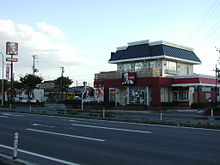KFC in Japan
 | |
 A stand-alone KFC drive-through unit in Hachinohe, Japan | |
Native name | 日本KFCホールディングス株式会社 |
|---|---|
| Formerly | "Old" Kentucky Fried Chicken Japan, Ltd. (1970–2014) |
| TYO: 9873 | |
| Industry | Fast food |
| Founded | July 4, 1970 |
| Headquarters | , |
Area served | Japan |
Key people | Masaki Kondo (President) |
| Brands | Redroof Pizza, Pizza Hut Japan, Natural Dining |
| Owner | Mitsubishi Corporation (35.12%) |
| Subsidiaries | Kentucky Fried Chicken Japan, Ltd. |
| Website | japan |
KFC (the name was originally an initialism for Kentucky Fried Chicken) is a fast food restaurant chain that specializes in fried chicken and is headquartered in Louisville, Kentucky, United States (US). It is the world's second largest restaurant chain (as measured by sales) after McDonald's, with 18,875 outlets in 118 countries and territories as of December 2013[update].
Japan is the third-largest market for KFC after China and the United States with 1,165 outlets as of December 2014.[1] In Japan, 70 percent of sales are takeout, with customers tending to buy fried chicken for parties and other special occasions and eating it as a side dish.[2]
History
[edit]KFC Japan was originally formed as a joint venture between its American parent KFC and Japan's Mitsubishi Corporation.[3] Following four years of negotiations, Mitsubishi was awarded the franchise rights to KFC in Japan, and a test store was opened at the Osaka World Expo in March 1970.[3]
After its successful debut, the first proper store was opened in the suburban location of Nagoya in November 1970.[4] KFC wanted suburban locations, whereas Mitsubishi argued for city center locations, as cars had not been widely adopted in Japan at that time.[4] Though two more locations were opened in suburban Osaka, the stores struggled, and after less than a year of operation, had lost JP¥ 100 million.[4] As a result of this failure, Mitsubishi's original plan for urban locations was pursued.[4]
The first outlet under the new approach opened in 1972 in Kobe, an upmarket residential area with a large Western expatriate community.[4] The strategy was a success, and by December 1973, 100 outlets had been opened.[4]
Harland Sanders himself visited the Japanese operations in 1972, 1978 and 1980.[5] In 1983 there were 390 outlets with annual sales just under $300 million.[6] By this time Japan was KFC's largest single foreign market.[6]
In August 1990, KFC Japan was listed on the Tokyo Stock Exchange.[7] KFC benefited from the economic boom in Japan during the 1980s, and grew to 1,000 outlets with annual sales of $1.2 billion by 1993.[8][9] However, the rapid expansion of outlets saw franchisees competing for market shares with each other, and around 100 outlets closed down in the mid-1990s.[8]
In 2000, KFC Japan reported sales of nearly $598 million.[10] In December 2007, Mitsubishi assumed majority control of KFC Japan in a JP¥ 14.83 billion transaction.[11]
Christmas
[edit]
In 1970, Takeshi Okawara—manager of the first KFC restaurant in Japan—began promoting fried chicken "party barrels" as a Christmas meal intended to serve as a substitute for the traditional American turkey dinner. Okawara marketed the party barrels as a way to celebrate Christmas, a holiday which lacked widespread traditions in Japan at the time.[12]
KFC Japan expanded the promotion nationwide in 1974 with its long running "Kentucky for Christmas" (Japanese: クリスマスはケンタッキー) or "Kentucky Christmas" (Japanese: ケンタッキークリスマス) advertising campaign.[4] Eating KFC food as a Christmas time meal has since become a widely practiced custom in Japan.[13][14][15] As of 2019[update], in Japan, Christmas sales of KFC made around Christmas Eve account for nearly five percent of annual revenue.[16]
References
[edit]- ^ "Restaurant counts". Yum!. Archived from the original on December 7, 2015. Retrieved Jan 3, 2016.
- ^ Tanikawa, Miki (August 18, 2001). "Fried Chicken Dilemma Is Puzzler for KFC Japan". New York Times. Archived from the original on October 5, 2013. Retrieved June 29, 2013.
- ^ a b "KFC Japan". Mitsubishi Corporation. Archived from the original on June 22, 2013. Retrieved June 29, 2013.
- ^ a b c d e f g "KFC Japan". Mitsubishi Corporation. Archived from the original on May 11, 2013. Retrieved June 29, 2013.
- ^ "Colonel's Story". KFC Japan. Yum!. Archived from the original on November 13, 2013. Retrieved November 13, 2013.
- ^ a b Carrel, Todd (12 July 1983). "Kentucky Fried Chicken, Japanese Style". Associated Press.
- ^ "KFC Japan". Mitsubishi Corporation. Archived from the original on May 11, 2013. Retrieved June 29, 2013.
- ^ a b "Competition Gains on Colonel Sanders in Japan". Los Angeles Times. August 14, 1995. Archived from the original on November 13, 2013. Retrieved June 29, 2013.
- ^ Okawara, Takeshi (Summer 1993). "Universality and particularity in globalization". Business Quarterly. 57 (4): 128–134.
- ^ Karan, Pradyumna (12 September 2010). Japan in the 21st Century: Environment, Economy, and Society. University Press of Kentucky. p. 330. ISBN 978-0-8131-2763-7. Archived from the original on 20 September 2023. Retrieved 18 October 2016.
- ^ "Mitsubishi takes over Kentucky Fried Chicken Japan for ¥14.83 billion". Japan Times. December 9, 2007. Archived from the original on November 13, 2013. Retrieved June 29, 2013.
- ^ Barton, Eric (December 19, 2016). "Why Japan celebrates Christmas with KFC". BBC Worklife. Archived from the original on February 22, 2020. Retrieved January 18, 2020.
- ^ Smith, K. Annabelle (December 14, 2012). "Why Japan is Obsessed with Kentucky Fried Chicken on Christmas". Smithsonian. Archived from the original on 2015-12-22. Retrieved 2015-12-16.
- ^ Gebreyes, Rahel (December 11, 2014). "How KFC Became A Part Of Japan's Christmas Traditions". The Huffington Post/The World Post.
- ^ Quigley, J.T., "A Kentucky Fried Christmas in Japan", The Diplomat, archived from the original on 2015-12-22, retrieved 2015-12-16
- ^ Anthony Dennis (December 24, 2019). "Why Japan is obsessed with KFC at Christmas". Stuff. Archived from the original on December 24, 2019. Retrieved December 24, 2019.
External links
[edit]- Official website (in Japanese)
